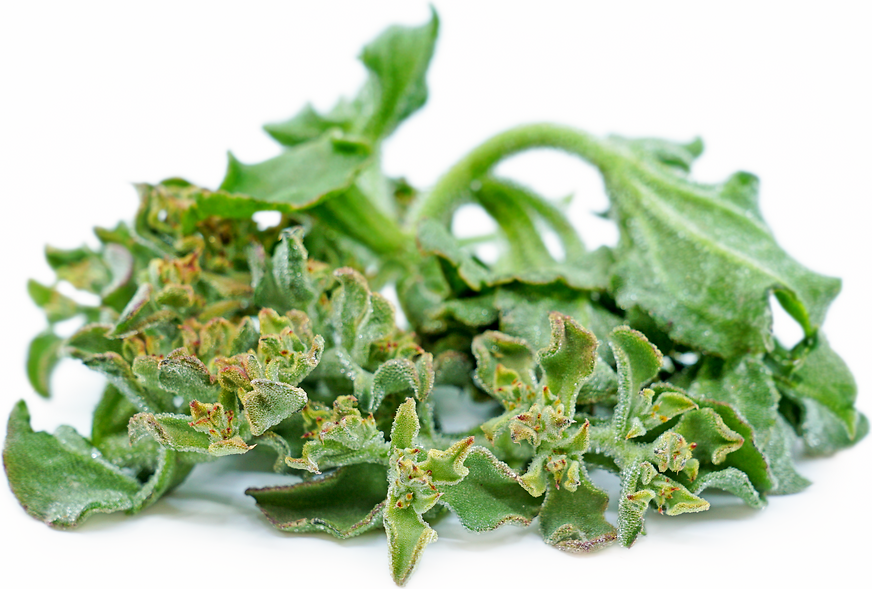


Barafu
Estimated Inventory, lb : 0
Description/Taste
Barafu is a trailing succulent comprised of branching stems with wide, flat, and oval leaves. The stems are crunchy, green, and semi-thick, and the attached leaves are wavy, crisp, and aqueous, averaging 2 to 20 centimeters in length and 2 to 3 centimeters in diameter. The leaves also range in color from green to orange-red, depending on maturity, and tiny, transparent cells cover the surface storing minerals and salt, creating the plant’s signature ice-droplet appearance. Barafu is known for its crisp and juicy consistency with a salty, neutral flavor.
Seasons/Availability
Barafu is available year-round.
Current Facts
Barafu, botanically classified as Mesembryanthemum crystallinum, is a low-growing succulent that belongs to the Aizoaceae family. Barafu is a variation of the Crystalline Ice Plant, which is widely naturalized throughout the United States, Europe, Africa, and Australia, but Barafu is distinguished from the wild variety as it has been specifically researched and developed for culinary use. Barafu roughly translates from Swahili to mean “crystal” or “ice,” which is derived from the plant’s origins in Africa and the leave’s ice-like appearance. When salt and other minerals are absorbed into Barafu leaves, the contents are kept in transparent cells or bags on the surface, creating the appearance of water droplets. Barafu is considered to be a specialty item, often sold at very high prices for its rarity, and can be used in a wide variety of both raw and cooked applications.
Nutritional Value
Barafu is a good source of beta-carotene, which is an antioxidant that is used in the body to produce vitamin A. The leaves also provide potassium, which can help regulate fluid levels within the body and contain manganese, calcium, vitamin K, and zinc. In addition to vitamins and minerals, Barafu contains proline, which is an amino acid that contributes to strengthening joints and increasing collagen production.
Applications
Barafu is best suited for both raw and cooked applications such as blanching, stir-frying, and steaming. The leaves and stems have a crunchy, salty flavor that can be tossed fresh into green salads, chopped and mixed into spring rolls, stirred into soups, or even blended into ice cream. Barafu can also be lightly stir-fried with other vegetables, steeped in boiling water for tea, used as a substitute for spinach, pickled for extended use, or utilized as an edible garnish. In Japan, Barafu is popularly battered and fried into tempura, creating a crisp, tender, and salty appetizer. Barafu pairs well with herbs such as mint, cilantro, basil, and coriander, peas, bell pepper, tomatoes, garlic, edible flowers, grapefruit, soy sauce, and noodles. The fresh leaves will keep 4-5 days when stored in a plastic bag in the crisper drawer of the refrigerator.
Ethnic/Cultural Info
In Japan, crystalline ice plant was first imported from Africa into the research labs at Saga University to study the way ice plant can help repair soil composition. In the middle of the study, a student of researcher Akihiro Nose suggested that the plant can also be consumed, sparking a twenty-year project to develop a commercially safe variety. Ice plant is highly praised for its ability to absorb and store salt, minerals, and other substances it is grown in. Though this is extremely beneficial to the plant and soil, studies have also shown that ice plant grown in soil may absorb unwanted contents such as pesticides, cadmium, and other heavy metals, which can be dangerous if consumed. As a result, Nose and his team of researchers eliminated the dangers of soil and worked to cultivate Barafu in an artificial environment known as Nutriculture or hydroponics, which is a method of growing the plant without soil.
Geography/History
Crystalline ice plant is native to the Namibian desert, which is located in southern Africa and has been growing wild since ancient times. The plant was introduced to Japan in 1985 and was extensively researched at Saga University for over twenty years as a potential commercial consumer good. To promote their new variety, researcher Akihiro Nose and associates created a venture firm known as Nokendo to market the ice plant under the new name Barafu, and the variety was released commercially in 2006. Today Barafu is challenging to find and is sold in limited quantities through specialty grocers in Japan. It is also exported to the United States and Europe.
Recipe Ideas
Recipes that include Barafu. One
| Rukia's Kitchen |
|
Barafu za Maziwa - Milk Popsicle |












